Elon Musk says Starship ‘will make life multiplanetary’ after most successful launch yet
Elon Musk has claimed his Starship rocket will “make life multiplanetary” after its most successful launch to date.
The SpaceX founder’s comments came after the world’s largest spacecraft carried out its third test flight in Texas.
In a post published shortly after the mission, Mr Musk, who has long harboured ambitions of colonising Mars, said: “Starship reached orbital velocity! Congratulations SpaceX team! Starship will make life multiplanetary.”
Staff at SpaceX’s Texas headquarters roared as Starship shut down its engines to coast through space for the first time after reaching a speed of around 26,500 kilometres per hour and an altitude of 200km. They cheered as cameras recorded its descent into Earth’s atmosphere.
However, the test was not a complete success as SpaceX lost contact with the spacecraft upon re-entry.
This led to cameras and telemetry signals failing, with the spaceship thought to be destroyed as it attempted to land in the Indian Ocean.
The Super Heavy Booster used to transport the spacecraft into orbit also crashed into the Gulf of Mexico after separating from Starship, as its engines failed to fully reignite for a soft landing at sea.
SpaceX also skipped a test to reignite Starship’s engines while in space, something that will be crucial for safely landing the spacecraft.
The test lacked the spectacle of SpaceX’s reusable rocket launches, in which the vehicles land vertically on launch pads, but provided views of the Earth and a rare glimpse of its rocket’s hull glowing with plasma as it descended.
Mr Musk did not appear to be present at SpaceX mission control during the launch, having held meetings in Germany and France on Wednesday.
The launch was delayed by more than an hour because of weather conditions at SpaceX’s “Starbase” headquarters in Boca Chica, Texas.
SpaceX said it was closely watching wind conditions in the run up to the launch, while there was also heavy fog.
However, skies cleared shortly before the launch.
SpaceX’s last two Starship missions ended mere minutes after launch, but the third flight lasted more than an hour and the company was able to conduct a series of key tests.
The rocket is a vital part of Nasa’s plans to land astronauts on the moon in 2026, as well as Mr Musk’s ultimate goal of sending humans to Mars.
The first two Starship tests had ended with the rocket exploding, although SpaceX insisted the launches had been moderate successes that had informed changes to its design.
Starship will make life multiplanetary pic.twitter.com/Ul7ksiAHBZ
— Elon Musk (@elonmusk) March 14, 2024
03:28 PM GMT
Thanks for joining us
That’s all from today’s mission - SpaceX’s most successful Starship launch yet. You can check out all the highlights below.
03:10 PM GMT
Starship will ‘make life multiplanetary’ says Elon Musk
Billionaire Elon Musk has hailed the company’s latest launch effort, claiming its Starship rocket will lead humans to colonise other planets. In a post on X, Mr Musk said: “Starship will make life multiplanetary.”
Mr Musk founded SpaceX 22 years ago with the goal of reaching Mars.
He has long harboured the ambition of taking humanity to other planets amid concerns over climate change or the risks of artificial intelligence.
NASA is aiming to use Starship to reach the Moon by 2026, returning mankind to its surface for the first time in over 50 years. It is then intending to use the rocket to reach Mars.
02:43 PM GMT
The best pictures of SpaceX’s Starship launch
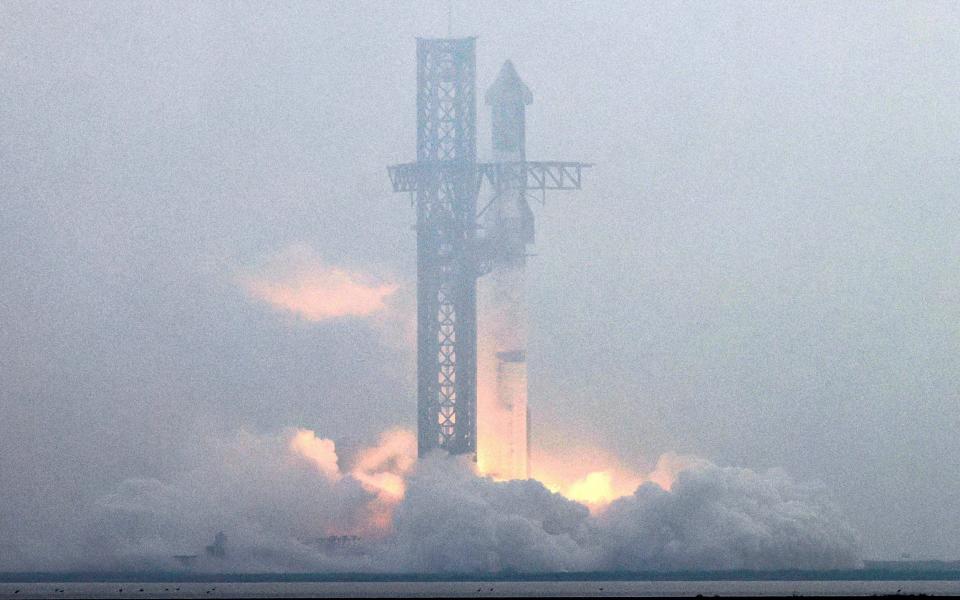
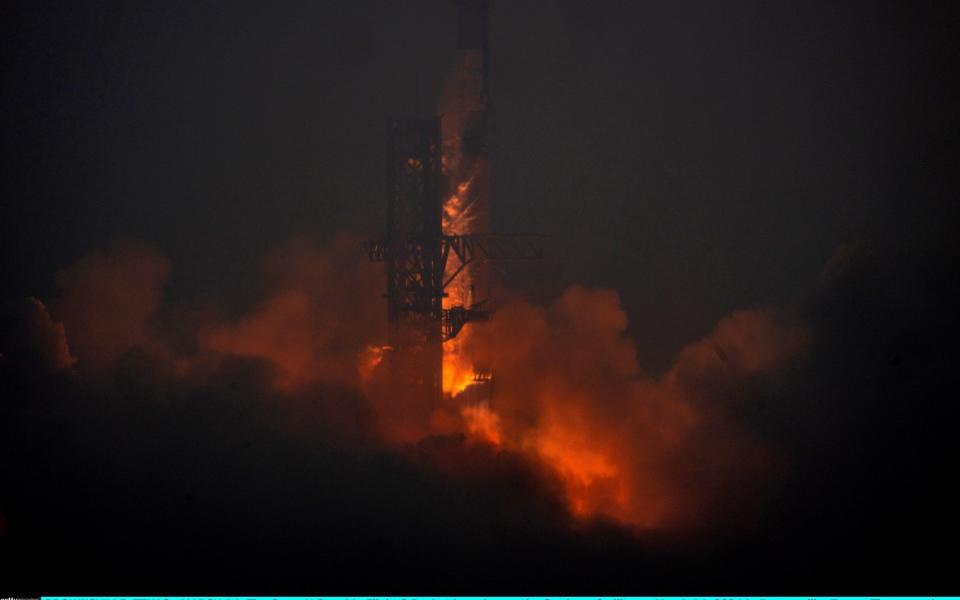


02:35 PM GMT
Confirmed: Starship lost on re-entry
While Starship did successfully reach space, the rocket was lost in the final stages of its mission. Still, the company’s engineers seemed pleased with the results, celebrating the company’s 22nd birthday with a celebratory “Pie”.
02:27 PM GMT
Starlink “data lost”
Starship engineers appear to believe that the ship may have been lost on its final approach on re-entry. The company lost satellite data and other signals simultaneously as glowing plasma built up, suggesting a sudden failure of the ship.
The rocket came close to completing all its mission objectives. It still has some way to go before it is ready for manned flight, however.
02:14 PM GMT
Starship soars back towards the earth
Starship is now travelling at almost 27,000 kilometres per hour, but sadly the signal from the ship appears to have largely been lost as a plasma field builds, blocking the video feed.
Here’s a stunning clip of Starship hurtling towards Earth’s atmosphere in the final seconds before signal was lost.
Starship re-entering Earth's atmosphere. Views through the plasma pic.twitter.com/HEQX4eEHWH
— SpaceX (@SpaceX) March 14, 2024
02:08 PM GMT
Starship heads towards re-entry
The rocket is now preparing for its approach back towards earth - however, there may be very little video from this final period of the flight, as a plasma field around the rocket disrupts signals from reaching earth.
Success would look like a splash down in the Indian Ocean with a “soft” landing. It has now descended from over 200km above the earth to around 100km in altitude.
The heat is starting to build on the ship’s flaps, creating a glowing plasma field.
01:55 PM GMT
Watch: SpaceX launches the world’s heaviest rocket
As Starship coasts through space towards the Indian Ocean, here is a recap of the launch so far and the successful blast off:
01:47 PM GMT
Elon Musk congratulates the SpaceX team
The billionaire did not appear to be in the mission control centre today - based on what we could see on the live feed - but Elon Musk has been following SpaceX’s launch on X, the social network he owns.
Starship reached orbital velocity!
Congratulations @SpaceX team!!— Elon Musk (@elonmusk) March 14, 2024
At ~5000 tons, Starship is the largest flying object ever made https://t.co/r5kzjpbD9B
— Elon Musk (@elonmusk) March 14, 2024
01:44 PM GMT
SpaceX conducts in-flight tests
Having made it into orbit, SpaceX is now using the mission to conduct a series of tests.
The rocket has opened and closed its bay doors, which will be critical for carrying satellites or other payloads into space.
It is also conducting a test of its propellant transfer systems for future in-flight refuelling.
01:40 PM GMT
The latest pictures from Starship’s third launch

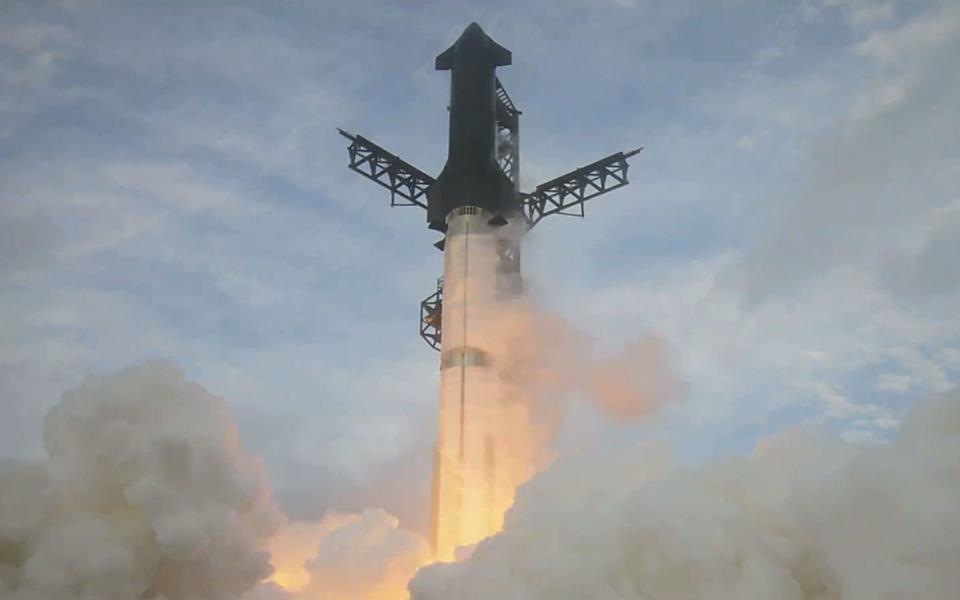
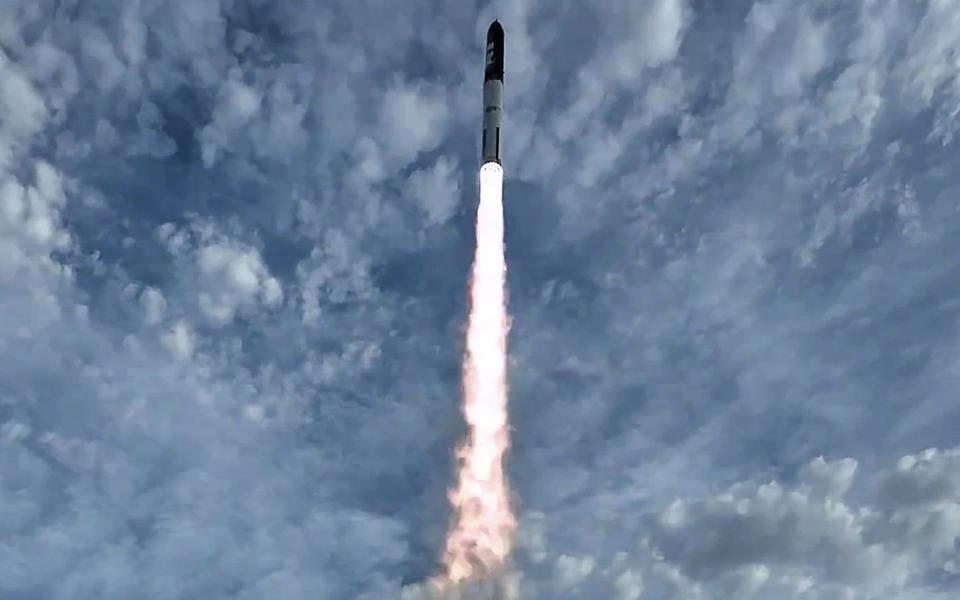
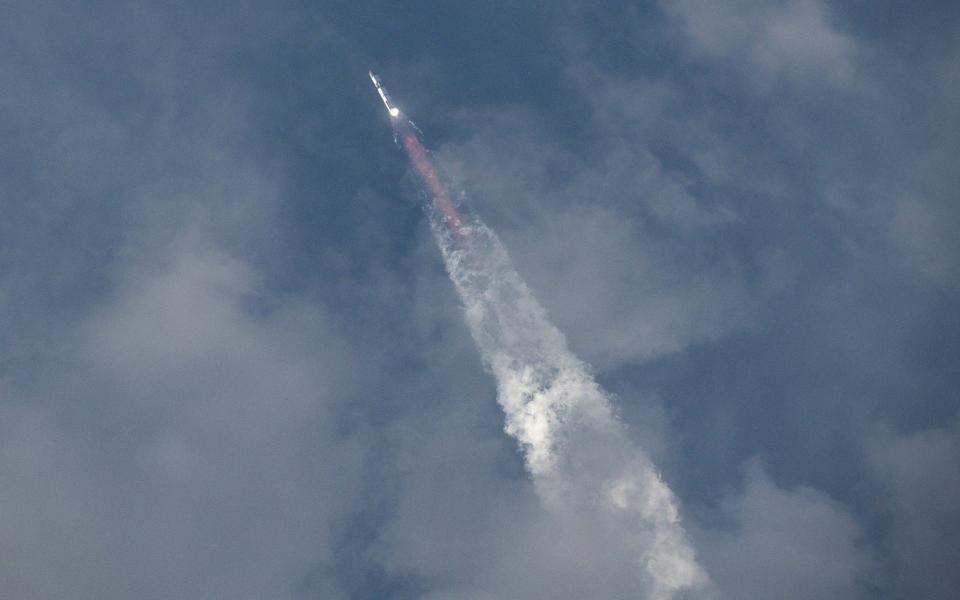

01:35 PM GMT
Engine cut off as Starship sails through space
Starship’s engines have shut down and it has reached a key orbital height and speeds of more than 25,000 kilometres per hour. The ship is now coasting through space just ten minutes into the flight.
Now, SpaceX will be undertaking a series of tests to try out the rocket’s systems as it sails above the earth, flying for about 30 minutes.
Having reached space and entered into its gliding phase, it marks a major step forward for SpaceX’s testing phase.
01:33 PM GMT
Super Heavy heads for a “splashdown”
Super Heavy descends through the clouds as it re-enters the atmosphere. Hurtling towards earth, a few engines have ignited, but the signal appears to have been lost...
Starship, however, is still flying through space and has now lasted eight minutes - “farther than we have gone on flight two”.
01:28 PM GMT
Super Heavy stage disconnects
Three minutes into the flight, the rocket’s booster has shut down and Starship’s engines have kicked in.
The Super Heavy booster has separated and now is falling back towards Earth.
This was the stage at which the first launch failed - so Starship has passed a key hurdle.
So far, things are looking good for Starship and Super Heavy.
01:26 PM GMT
Lift off!
Starship has blasted off, its 33 raptor engines carrying Super Heavy to five kilometres 30 seconds into flight - speed now 1000kmph. Cheers erupt among the ground staff.
01:25 PM GMT
T-minus 10 seconds
“Go for launch.”
01:24 PM GMT
T-minus one minute
“Winds are not going to hold us up,” says SpaceX’s spokesman.
01:23 PM GMT
How SpaceX’s Starship re-entry should look
Providing we don’t see an early explosion or misfire, SpaceX has shared a video on how the re-entry of Starship into Earth’s atmosphere should look:
If Starship manages to make it all the way to reentry, we'll collect valuable data on reentry at hypersonic speeds, or more than 5 times the speed of sound pic.twitter.com/jYXrttLcuE
— SpaceX (@SpaceX) March 14, 2024
01:22 PM GMT
T-minus three minutes
SpaceX can hold the launch for a further 15 minutes at T-minus 40 seconds, should the winds be a little too high for comfort.
About 3 mins before launch T-0 https://t.co/HjDJNsxlNM
— Elon Musk (@elonmusk) March 14, 2024
01:12 PM GMT
Countdown ‘pretty clean’
With just under 15 minutes left to go until launch, SpaceX say conditions are looking “pretty clean” for take off, although the company is keeping an eye on winds.
Fuelling will be finished around three and a half minutes before takeoff, while engineers will make a last-ditch decision at T-minus 40 seconds about whether to hold the launch due to winds.
It says there are backup opportunities in the coming days if the launch does not go ahead today.
01:05 PM GMT
Trajectory for today’s launch
Starship is expected to take off from Texas before orbiting most of the earth’s circumference and splashing down in the Indian Ocean off the West coast of Australia.
Starship's flight trajectory for today's test pic.twitter.com/1YJbO1tRxz
— SpaceX (@SpaceX) March 14, 2024
12:56 PM GMT
Live stream begins
We will be embedding the SpaceX live stream above for you to tune in shortly.
SpaceX says it has made a series of improvements and upgrades since its last two missions improving fire protection and reinforcing its launch pad.
While today’s mission may end with the rocket breaking up or exploding, ever launch gathers extra data for a potential future manned mission.
Here is how SpaceX describes it:
Starship’s second flight test achieved a number of major milestones and provided invaluable data to continue rapidly developing Starship. Each of these flight tests continue to be just that: a test. They aren’t occurring in a lab or on a test stand, but are putting flight hardware in a flight environment to maximize learning.
12:52 PM GMT
Super Heavy booster now fuelling
Prop load of the Super Heavy booster is underway
— SpaceX (@SpaceX) March 14, 2024
12:36 PM GMT
Fuelling begins
The SpaceX team have started loading propellant into the upper stage of Starship, a positive sign that today’s launch could still happen, although it has now been delayed by over an hour.
“Propellant load of Starship’s upper stage is now underway,” SpaceX said on Twitter.
12:27 PM GMT
New launch time 1.25pm
SpaceX says the launch now will not take place until 1.25pm, noting they are “keeping an eye on winds”. If the wind speed is too high the launch could be cancelled for another day.
The Starship team is go for prop load but keeping an eye on winds, now targeting 8:25 a.m. CT for liftoff → https://t.co/G1H8uoTxWD
— SpaceX (@SpaceX) March 14, 2024
12:09 PM GMT
Launch delayed another ten minutes
Shifting T-0 a few more minutes to give boats time to clear the keep out area, now targeting 8:10 a.m. CT
— SpaceX (@SpaceX) March 14, 2024
11:55 AM GMT
Launch delayed to 1pm
SpaceX says it is still clearing a few boats from the Gulf of Mexico and launch has been pushed back until 1pm UK time.
New liftoff time is 8:02 a.m. CT, team is clearing a few boats from the keep out area in the Gulf of Mexico
— SpaceX (@SpaceX) March 14, 2024
11:51 AM GMT
How today’s Starship launch should play out
Starship, sitting atop the Super Heavy Booster, will launch at approximately 12.30pm today, William Currie writes.
The booster will light up its 33 Raptor engines for a third time. Around three minutes into flight the main engines of the booster will cutoff, and the Starship will disconnect, lighting its six engines in a fiery “hot staging” event as it continues into space. The first stage will come down and splash land in the Gulf of Mexico.
On this flight while in orbit, the second stage will attempt a series of new tests. Firstly, Starship will open and close its payload door when in orbit. Second, the ship will conduct a propellant transfer demonstration during its coast phase. Finally SpaceX will attempt the first ever re-light of a Raptor engine while in space.
The second stage will proceed on a new trajectory, this time attempting a “soft” landing over the Indian Ocean as opposed to off the coast of Hawaii. The ultimate goal is for both Starship and the Super Heavy booster to one day be fully reusable, landing safely on shore or a barge at sea.
But for now, both first and second stages will land rather “hard” at sea.
11:43 AM GMT
Previous launches
Despite SpaceX’s many successes, its Starship rocket has something of a fiery past leading up to today’s test flight.
Check it out below:
11:29 AM GMT
Weather ‘70pc favourable’
SpaceX says the weather for today’s flight appears “favourable” as it prepares for Starship’s third test flight.
The launch time is now 7.30am local time, pushing things back by about half an hour. The live stream will begin thirty minutes beforehand.
Weather is 70% favorable for today's third integrated flight test of Starship.
The live webcast will begin ~30 minutes before liftoff, which is currently targeted for 7:30 a.m. CT → https://t.co/G1H8uoTxWD pic.twitter.com/uN3I9WBtKe— SpaceX (@SpaceX) March 14, 2024
11:27 AM GMT
The latest pictures from Boca Chica





11:19 AM GMT
Starship’s test flight stages
The last two test flights ended in failure - albeit with November’s launch actually reaching space - so you may be forgiven for questioning whether today’s test will be any different.
However, if it all goes to plan, here is a graphic outlining exactly how the launch should go:
10:55 AM GMT
How Elon Musk’s SpaceX is transforming space exploration
Since founding SpaceX in 2002, Elon Musk has turned the space sector on its head, launching hundreds of privately-owned rockets into space.
His company has become the world’s most important space business and has been tasked by NASA with returning humans to the Moon on its Artemis mission in two years time.
The company’ mainstay rocket - the Falcon 9 - is designed to be reusable, featuring a booster that can return it to earth and land safely, saving on costs.
The Starship is built to be similarly reusable. The rocket will take off later today consisting of two stages. The first is its Super Heavy booster, which is 230 ft tall and has 33 engines, powered by a mix of liquid oxygen and methane generating 17 million pounds of thrust, more than twice that of the Saturn V rockets used to send Apollo astronauts to the moon.
About three minutes into the flight, the Super Heavy booster will separate and land in the Gulf of Mexico, while the second stage, Starship, will fire up its six raptor engines.
The rocket parts are ultimately intended to be used again. In today’s mission Starship will glide down before splashing into the Indian Ocean - if everything goes to plan.
10:27 AM GMT
More details on Musk’s ‘super heavy’ rocket
SpaceX’s Starship is the world’s biggest rocket, measuring 120 metres tall and nine metres across, with a payload of between 100 and 150 metric tonnes.
10:24 AM GMT
‘Ambitious objectives’
Here is what SpaceX has to say in today’s mission briefing:
The third flight test aims to build on what we’ve learned from previous flights while attempting a number of ambitious objectives, including the successful ascent burn of both stages, opening and closing Starship’s payload door, a propellant transfer demonstration during the upper stage’s coast phase, the first ever re-light of a Raptor engine while in space, and a controlled reentry of Starship.
It will also fly a new trajectory, with Starship targeted to splashdown in the Indian Ocean. This new flight path enables us to attempt new techniques like in-space engine burns while maximising public safety.
Starship launch attempt in ~5 hours
pic.twitter.com/cEBv1EHsQf— Elon Musk (@elonmusk) March 14, 2024
10:11 AM GMT
What time is the SpaceX launch today?
Starship is on the launch tower at Elon Musk’s Starbase spaceport in Boca Chica, Texas, as we count down to its third test flight.
The launch is due to take place in the early morning local time, providing there are no last minute delays. Originally it was slated for 12pm UK time, but has since been pushed back to 12.30pm.
The livestream should begin roughly 30 minutes before lift-off, when we should get more details on the mission ahead. We will feature the livestream right here in our live blog, but you can also watch it on SpaceX’s website.
All being well, the rocket should launch around midday. The rocket booster, which is designed to be reusable, will separate and fly back to earth.
It should then reenter above the Indian Ocean before splashing down into the sea for an “exciting landing”, SpaceX says.
